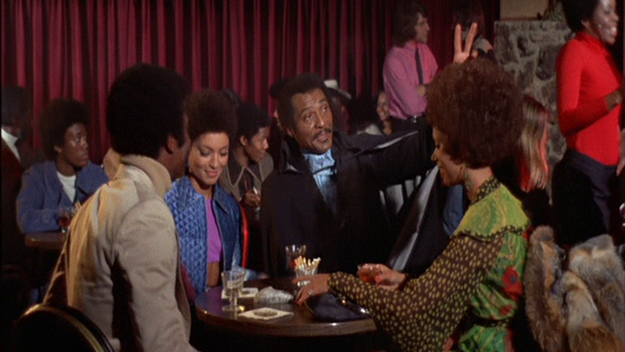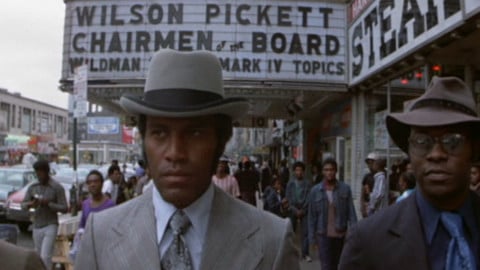Deep Cuts: The Stars and Bars of Blaxploitation and Its Soundtracks
Some reading music: listen to this week’s special mix below. (See the full track listing.)
Following up on the theme of last month’s column, Anthology Film Archives’ current tribute to American International Pictures is set to screen some of the genre’s best soundtracks, attached to titles such as Coffy, Foxy Brown, Sugar Hill, and Blacula, among others. Two of those films star Pam Grier, who began her career as a receptionist at AIP. In many respects the most recognizable face of blaxploitation cinema, Grier had an indelible run of starring roles in AIP productions that are highlighted by a string of knockout opening title themes.
https://www.youtube.com/watch?v=w24xg413amk
Vibraphonist Roy Ayers set a cool room tone for Grier’s breakout film with his pervasively funky, proto-acid-jazz soundtrack to Jack Hill’s bitterly violent Coffy (73). Grier makes an impressive entrance a few minutes into the film under the clever guise of a strung out junkie, angelically dozing in the back seat of someone else’s car. The opening credits, accompanied by Ayers’ “Coffy is the Color” appear through the windshield while Coffy (who is actually a sober vigilante) talks dirty to a lecherous drug dealer in the back seat. Cruising along the familiar rapid-fire scratch of a wah-wah guitar, “Coffy is the Color” plays to the driver’s headlong view of Wilshire Boulevard in Los Angeles, prowling forward under the nighttime glow of street lamps and neon signs. The song’s hypnotic male-female harmonies spread out on an even keel while a somber keyboard melody repetitively tumbles downscale at the start of every fourth measure. Sharp injections of horn music alternately yank our attention back to the steady groove of the rhythm section and the cycle starts anew. The album version of “Coffy is the Color” sounds even fuller, is better recorded, and runs a minute longer with an ecstatic vibraphone solo. Backed up by his legendary “Ubiquity” band, the soundtrack to Coffy is still considered to be one of Roy Ayers’ best albums.
No disrespect to Willie Hutch, whose formidable contributions to the genre include consecutive soundtracks to The Mack (73) and Foxy Brown (74), but his title track for Coffy‘s intended sequel sounds a bit overblown in contrast to Ayers’ seamless loop. In fact, everything surrounding the production of Foxy Brown (or Burn, Coffy, Burn, as it was originally titled) was pushed to the limit by AIP. Forced to convert his sequel into a standalone film on a compromised budget, Jack Hill revealed to Josiah Howard in his book Blaxploitation Cinema that the completed Foxy Brown frustrated and “haunted him for years.” The trippy opening credits, filmed without Hill’s approval, washed away most of Foxy’s grit by imitating the psychedelic cabaret of the iconic James Bond title sequences. The sonic equivalent of a luxury cruise, Willie Hutch’s theme glides right over Grier’s rotoscoped karate kicks, even when she appears to be dancing to a different song. Hutch layers the song with cooing backup vocals and suffocating strings that crowd his leading melody. Three years before the television debut of Charlie’s Angels’ similar but less dynamic opening, Hutch’s sycophantic theme helped establish Pam Grier as a leading lady worthy of a grand introduction. AIP followed through with two more starring vehicles for Grier; Sheba, Baby and Friday Foster (both released in 1975) that also opened with catchy title themes describing her characters’ awe-inspiring talents (namely, looking hot and kicking ass).
The 1974 zombie-horror film Sugar Hill opens with the Originals’ “Supernatural Voodoo Woman,” an indirect ode to the film’s lead played by Marki Bey. Written by the film’s composers, Motown hit makers Nick Zesses and Dino Fekaris, the track plays out in full over images of a phony voodoo ritual being performed for an elite (read: boring/white/tourist) audience at “Club Haiti” in New Orleans. Overseen by the club’s proprietor and his girlfriend, Diana ‘Sugar’ Hill, this unsubtle bit of foreshadowing serves as both a poor showcase for the Originals’ fantastic opening song and a lamentably flat introduction to the stunning Marki Bey, the supernatural voodoo woman herself. Bey is off-screen throughout the performance, presumably sipping a cocktail at the bar; a far cry from parading in front of the camera wearing an array of glamorous outfits and wigs à la Foxy Brown.
Blacula
Contrived club scenes popped up often in blaxploitation films with independently marketable soundtracks. Last month’s column touched on Curtis Mayfield’s subversive cameo in Super Fly, while Blacula (72), also screening this month at Anthology, features two literal showstoppers by The Hues Corporation, performing as the “house band” at Blacula’s local watering hole. Darktown Strutters (75), a cartoonish film that proudly abandons any semblance of reality, foregoes the usual club-terfuge for a magical number in an underground jail cell by the Dramatics, in which they lip-sync to their mesmerizing single “What You See is What You Get.” (Darktown Strutters screens at MoMI at the end of the month on a Jack Fisk-connected double bill with 1973’s extraordinary Messiah of Evil.)
Essentially working as independent contractors, a few of the bigger names in music used their blaxploitation scores as an opportunity to test out new ground, rather than simply cross-promote their current single with the latest film. Last month we looked at Marvin Gaye’s lone soundtrack for Ivan Dixon’s Trouble Man (72), which represented an unexpected step in a new musical direction for Gaye following the massive success of his previous album What’s Going On. And while Trouble Man failed to garner critical acclaim, director Ivan Dixon still managed to secure one of the top musical talents for his next film when he successfully courted Herbie Hancock to compose the soundtrack for his brutal takedown of politically-motivated tokenism, The Spook Who Sat by the Door (73). The final album that Hancock recorded with his Mwandishi sextet, the soundtrack to The Spook Who Sat by the Door is funky, experimental and largely electronic. Existing on a separate planet from Hancock’s relatively trad-jazz score for Antonioni’s Blow-Up, though more commercial still than his recent Sextant album, elements of The Spook soundtrack anticipated Hancock’s contemporary work with the newly formed Headhunters.
https://www.youtube.com/watch?v=XJyVwkuxYKQ
Released during a busy crossover period of Hancock’s career, the now-endangered Spook soundtrack album was recorded directly off the finished film with the overlapping dialogue still intact. Evidence of LP’s very existence is hard to find but Bob Gluck attests to the vinyl’s pressing in his book You’ll Know When You Get There: Herbie Hancock and the Mwandishi Band, and the Massachusetts-based record label Forced Exposure pressed a limited reissue in 2011 that is already out of print. Gil Scott-Heron and Brian Jackson’s little-known soundtrack for Phillip Fenty’s sole directorial effort The Baron (77) also suffered from a questionable, evidently long lost release. Fenty wrote the screenplay for Super Fly and while the premise of The Baron may have looked good on paper, the film itself is lamentably slow.
Roger Hamilton Spotts’ exotica-tinged title theme for the bizarre blaxploitation porn film Tongue (76) provides us with a decent closing example of an obscure “deep cut” that just happens to share a bass line with The Osmond Brothers’ anti-pollution anthem, “Crazy Horses.” If only the Tongue soundtrack had preceded the Mormon brothers’ G-rated single, this column would have tapped out with a glorious conjecture . . . but alas, the merely sinful association of the two songs will have to do.
http://www.dailymotion.com/video/x28j5t_the-osmonds-crazy-horses_music
Track list:
1. “Revolution” (The Spook Who Sat by the Door)
2. The Originals, “Supernatural Voodoo Woman” (Sugar Hill)
3. Ward L. Chandler / Luchi De Jesus, “Friday Foster” (Friday Foster)
4. Gil Scott-Heron and Brian Jackson, “A Bright Light on the Dark Side of Town” (The Baron)
5. Herbie Hancock, “At the Lounge” (The Spook Who Sat by the Door)
6. Monk Higgins and Alex Brown, “B.B.D.” (Sheba, Baby)
7. Gene Page, “Blacula Strikes!” (Blacula)
8. Roger Hamilton Spotts, “Tongue” (Tongue)
9. Roy Ayers and Ubiquity, “Coffy is the Color” (Coffy)
10. “Dynamite, Sugar” (Sugar Hill)
11. Jerry Butler and Jerry Peters, “I Can’t Let You Go” (Melinda)
12. Monk Higgins and Alex Brown, “Heavyshot” (Sheba, Baby)
13. Monk Higgins and Alex Brown, “Sheba Baby” (Sheba, Baby)
14. Luchi De Jesus, “Friday” (Friday Foster)
15. Gil Scott-Heron and Brian Jackson, “The Baron’s Theme” (The Baron)
16. Roy Ayers and Ubiquity, “King George” (Coffy)
17. Willie Hutch, “Out There” (Foxy Brown)
18. The Dramatics, “Whatcha See is Whatcha Get” (Darktown Strutters)
19. Jerry Butler and Jerry Peters, “Part III” (Melinda)
20. Jerry Butler and Jerry Peters, “Speak the Truth to the People” (Melinda)
21. “Who Are You Mister” (The Baron)
22. “Death Sentence” (Sugar Hill)
Margaret Barton-Fumo is the editor of a forthcoming book on Paul Verhoeven and a longtime contributor to FILM COMMENT.





